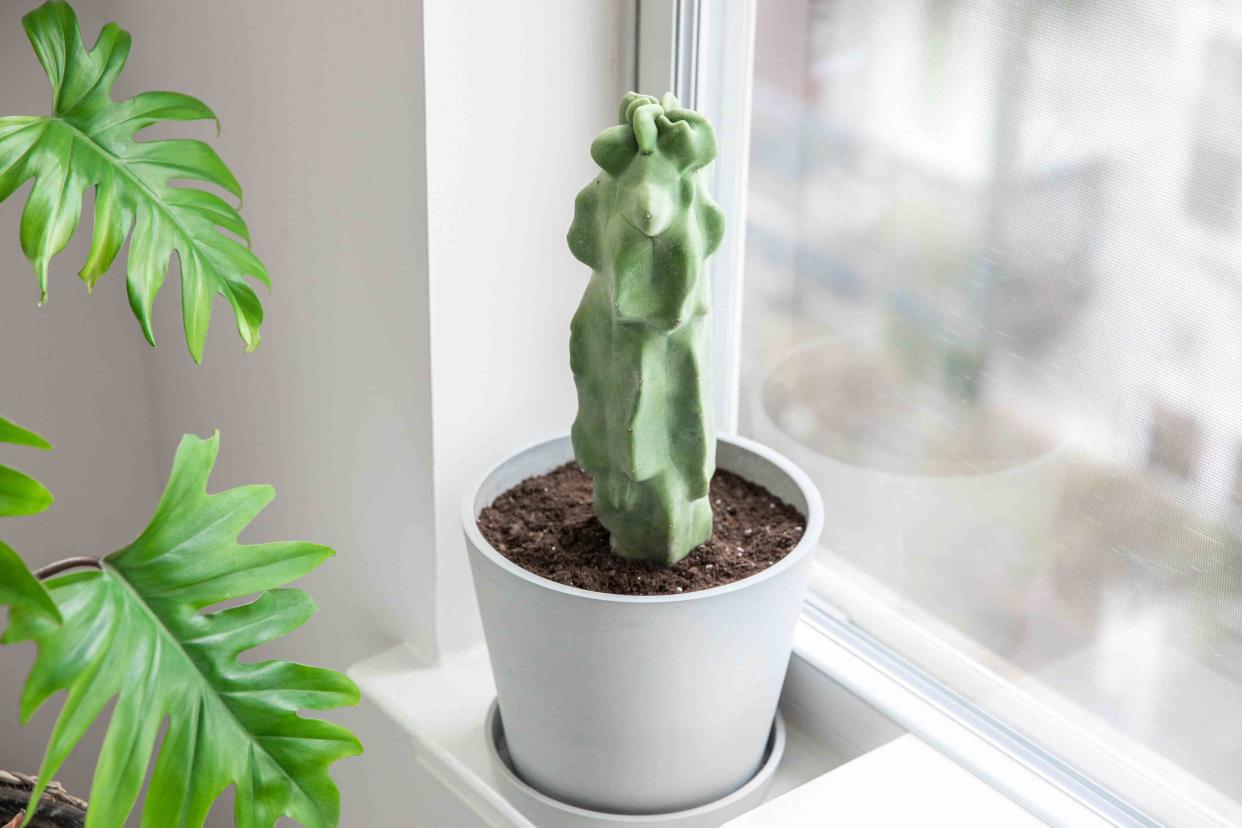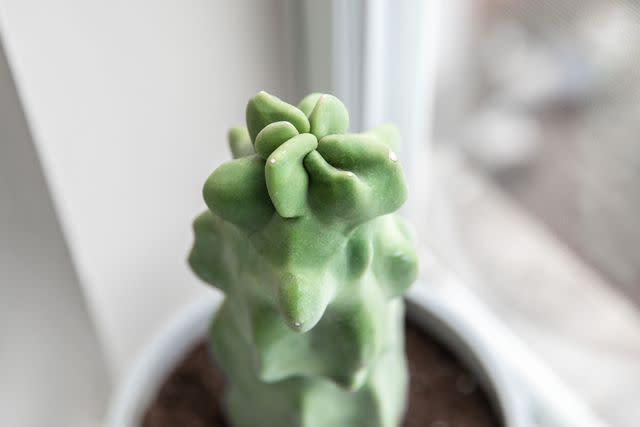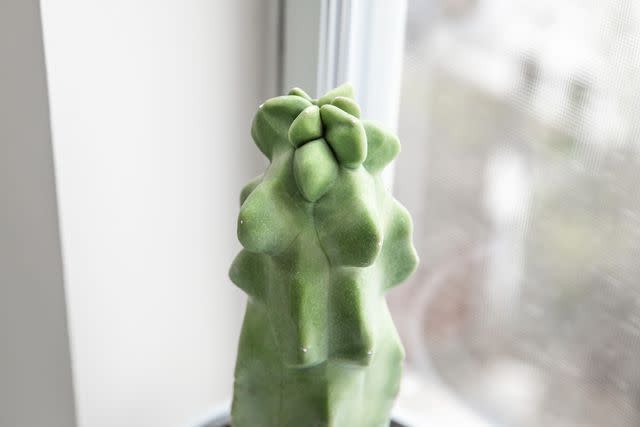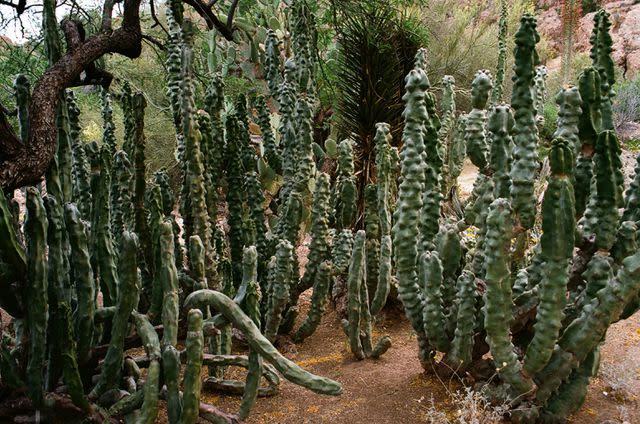How to Grow and Care for the Totem Pole Cactus

The Spruce / Anastasia Tretiak
Reviewed by Kathleen Miller
The totem pole cactus is a slow-growing cactus known for its tall, columnar growth habit and bumpy, spineless skin. It gained its common name from its textured stems, which resemble totem poles with many faces. The totem pole cactus grows best in arid, warm desert climates in bright, direct light, well-draining, acidic soil, and can withstand short bouts of temperatures that go down to 25 degrees Fahrenheit.
Common Name | Totem pole cactus, monstrous whisker cactus |
Botanical Name | Pachycereus schottii var. monstrosus (previously Lophocereus schottii var. monstrosus) |
Family | Cactaceae |
Plant Type | Cactus, perennial |
Mature Size | 6-8 ft. tall, 3-4 ft. wide (indoors) and 15 ft. tall and wide (outdoors) |
Sun Exposure | Full |
Soil Type | Sandy, well-drained |
Soil pH | Acidic, neutral |
Flower Color | Pink |
Bloom Time | Spring |
Hardiness Zones | 9-11 (USDA) |
Native Area | North America |
Totem Pole Cactus Care
Here are the main care requirements for growing a totem pole cactus.
Give this cactus several hours of bright, direct sun daily.
Plant it in a cactus or succulent potting mix.
Underwater, rather than overwater, this plant.
Indoors, keep the cactus away from drafty areas or air vents.

The Spruce / Anastasia Tretiak

The Spruce / Anastasia Tretiak

apollob66 / Getty Images
Light
Providing these desert cacti with enough light is one of the most important aspects of their care. Totem pole cacti need lots of sunlight to stay happy and should be grown in a location that gets several hours of bright, direct light every day. Directly in front of a west- or south-facing window are both great options if you are growing it indoors. A lack of light will cause these cacti to grow leggy.
Soil
Like most cacti, the totem pole cactus should be planted in a gritty, well-draining soil mix. Cactus and succulent soil are both great options or mix DIY cactus soil at home. Simply combine equal parts indoor potting soil, sand, and perlite to create a sandy, well-draining mixture that your totem pole cactus will love.
Water
Totem pole cacti are extremely drought tolerant and susceptible to overwatering and root rot. Ensure that the soil dries out thoroughly between waterings and remember that it is better to underwater these cacti than to overwater them. Cut back on watering in the fall and winter months when the cactus goes dormant. This means that during the summer you may need to water your totem pole cactus once every one to two weeks, whereas in the winter you can likely get away with watering once a month.
Temperature and Humidity
Native to the hot, arid regions of central and South America, the totem pole cactus thrives as a houseplant where conditions are usually warm and dry. These cacti can also be grown outdoors year-round in USDA regions 9 to 11, but are not cold- or frost-tolerant and should be grown indoors or moved indoors during the winter if you live outside of these regions. If you are growing your totem pole cactus indoors, be sure to keep it away from cold, drafty windows or air vents.
Fertilizer
Totem pole cacti are not considered high feeders but can benefit from regular feeding during the active growing season. Apply a cactus fertilizer once a month during the spring and summer for the best results.
Propagating Totem Pole Cactus
The totem pole cactus is a mutant of the cactus Pachycereus schottii, and as such, it cannot be grown from seed and can only be propagated vegetatively. The cactus rarely produces a flower and when it does, it is sterile, and will not produce seeds. However, these cacti can be successfully propagated using stem cuttings. This plant is slow-growing so patience is necessary. Take these simple steps.
Using a sharp, non-serrated knife, take a stem cutting from a healthy totem pole cactus. Ensure the cutting is at least a couple of inches long for best results.
Set the stem cutting aside for 24 hours and allow the cut end to callus over completely.
Prepare a small pot with cactus soil and then plant the cutting in the soil, pressing the base of it down slightly into the soil. Place the freshly potted cuttings in a location that receives plenty of bright, direct sunlight.
Do not water the cuttings for at least two to three weeks. This is important—the cuttings do not have roots and cannot absorb any moisture from the soil. Watering the cuttings prematurely will cause them to rot and die. If you want to be extra sure, you can gently tug on the cuttings to see if they have started to establish any roots before watering, but this can sometimes cause accidental root damage. If you don’t want to try manually checking, it is usually best to wait at least a few weeks before you begin watering.
Potting and Repotting a Totem Pole Cactus
Since these cacti are so slow-growing they do not require frequent repotting. Once every two to three years is usually sufficient. Repotting should also be done during the spring or summer months when the plant is actively growing. When it is time to repot your cactus, choose a new pot that is only a few inches larger than the last pot. Increasing the pot size too quickly does not benefit the plant in any way and can cause accidental overwatering. Fill the new pot with fresh potting mix before transferring the cactus from its outgrown container.
Common Pests and Plant Diseases
Totem pole cacti are susceptible to a few common pests and plant diseases. Keep an eye out for signs of mealybugs, scale, and aphids. Treat accordingly at the first sign of an infestation. These desert cacti are also susceptible to root rot if they are exposed to overwatered conditions. Ensure that the soil dries out thoroughly between waterings and that your cactus is potted in a well-draining soil mix to help prevent this devastating plant disease.
Common Problems With a Totem Pole Cactus
For the most part, the totem pole cactus is low-maintenance and easy to grow. However, there are a few issues that you may encounter when growing this desert cactus. Keep an eye out for the following common problems.
Splitting Stems
Split stems are caused by overwatering. Cacti are extremely efficient at storing and absorbing water, and if they absorb too much water too quickly it can cause the cacti’s skin to swell and eventually split. Usually, this happens when the plant is subjected to a long period of drought and then watered excessively. While a split in your totem pole cactus may be unsightly, it will not cause long-term damage to the plant, as long as the underlying watering issue is fixed.
Mushy Stems
If you notice the stem of your totem pole cactus is getting brown and mushy. your plant is likely suffering from root rot. Unfortunately, once mushy stems have set in it is usually too late to save the plant’s roots. However, the cactus itself can be saved by cutting the stems off above the rot and propagating them in fresh soil.
Black Spots
Black spots on a cacti’s skin can be the result of a few different issues but usually, the culprit is a fungal infection or chemical damage. Fungal infections are usually introduced to the plant through open cuts or wounds on its skin and can be treated by pruning away the affected area or applying a fungicide for larger infections. Chemical damage can occur when the cactus is over-fertilized or exposed to fertilizer or soil additives that contain metals such as zinc or iron. For the most part, chemical damage is usually cosmetic, and as long as the offending product is not applied further, should not affect the long-term health of the plant.
Turning Yellow
Cacti turn yellow when they are suffering from underwatering or shock. A drastic change in growing conditions (amount of light, temperature, watering schedule, etc.) can cause shock in an otherwise healthy plant, and can also result in accidental underwatering. Watering your cactus more frequently should help resolve the issue over time.
Frequently Asked Questions
Is the totem pole cactus rare?
The totem pole cactus is rare and tough to find since it only grows in small areas of Mexico and California.
How do I take care of a totem pole cactus?
A totem pole cactus is not difficult to take care of once you find one. Warm temperatures and lots of sunlight are pretty much all that is needed to keep this cactus happy, and it does well growing in containers and garden beds alike.
How fast will a totem pole cactus grow?
The totem pole cactus is not a fast grower. It's incredibly slow, growing up to 3 inches a year.
Read the original article on The Spruce.

